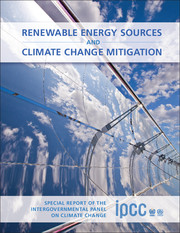 Renewable Energy Sources and Climate Change Mitigation
Renewable Energy Sources and Climate Change Mitigation Book contents
- Frontmatter
- Contents
- Section I
- Section II
- Section III
- Chapter 1 Renewable Energy and Climate Change
- Chapter 2 Bioenergy
- Chapter 3 Direct Solar Energy
- Chapter 4 Geothermal Energy
- Chapter 5 Hydropower
- Chapter 6 Ocean Energy
- Chapter 7 Wind Energy
- Chapter 8 Integration of Renewable Energy into Present and Future Energy Systems
- Chapter 9 Renewable Energy in the Context of Sustainable Development
- Chapter 10 Mitigation Potential and Costs
- Chapter 11 Policy, Financing and Implementation
- Section IV
- Index
- References
Chapter 3 - Direct Solar Energy
Published online by Cambridge University Press: 05 December 2011
- Frontmatter
- Contents
- Section I
- Section II
- Section III
- Chapter 1 Renewable Energy and Climate Change
- Chapter 2 Bioenergy
- Chapter 3 Direct Solar Energy
- Chapter 4 Geothermal Energy
- Chapter 5 Hydropower
- Chapter 6 Ocean Energy
- Chapter 7 Wind Energy
- Chapter 8 Integration of Renewable Energy into Present and Future Energy Systems
- Chapter 9 Renewable Energy in the Context of Sustainable Development
- Chapter 10 Mitigation Potential and Costs
- Chapter 11 Policy, Financing and Implementation
- Section IV
- Index
- References
Summary
Executive Summary
Solar energy is abundant and offers significant potential for near-term (2020) and long-term (2050) climate change mitigation. There are a wide variety of solar technologies of varying maturities that can, in most regions of the world, contribute to a suite of energy services. Even though solar energy generation still only represents a small fraction of total energy consumption, markets for solar technologies are growing rapidly. Much of the desirability of solar technology is its inherently smaller environmental burden and the opportunity it offers for positive social impacts. The cost of solar technologies has been reduced significantly over the past 30 years and technical advances and supportive public policies continue to offer the potential for additional cost reductions. Potential deployment scenarios range widely—from a marginal role of direct solar energy in 2050 to one of the major sources of energy supply. The actual deployment achieved will depend on the degree of continued innovation, cost reductions and supportive public policies.
Solar energy is the most abundant of all energy resources. Indeed, the rate at which solar energy is intercepted by the Earth is about 10,000 times greater than the rate at which humankind consumes energy. Although not all countries are equally endowed with solar energy, a significant contribution to the energy mix from direct solar energy is possible for almost every country. Currently, there is no evidence indicating a substantial impact of climate change on regional solar resources.
- Type
- Chapter
- Information
- Renewable Energy Sources and Climate Change MitigationSpecial Report of the Intergovernmental Panel on Climate Change, pp. 333 - 400Publisher: Cambridge University PressPrint publication year: 2011
References
- 25
- Cited by
